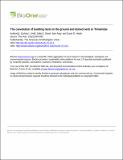Files in this item
The coevolution of building nests on the ground and domed nests in Timaliidae
Item metadata
| dc.contributor.author | Hall, Z.J. | |
| dc.contributor.author | Street, S.E. | |
| dc.contributor.author | Auty, S. | |
| dc.contributor.author | Healy, S.D. | |
| dc.date.accessioned | 2015-05-21T16:01:03Z | |
| dc.date.available | 2015-05-21T16:01:03Z | |
| dc.date.issued | 2015-07 | |
| dc.identifier | 189275862 | |
| dc.identifier | a8de5105-724c-4671-b3d1-50f4d6391691 | |
| dc.identifier | 84929001446 | |
| dc.identifier | 000358289000007 | |
| dc.identifier.citation | Hall , Z J , Street , S E , Auty , S & Healy , S D 2015 , ' The coevolution of building nests on the ground and domed nests in Timaliidae ' , The Auk , vol. 132 , no. 3 , pp. 584-593 . https://doi.org/10.1642/AUK-15-23.1 | en |
| dc.identifier.issn | 0004-8038 | |
| dc.identifier.other | ORCID: /0000-0002-8059-4480/work/60631235 | |
| dc.identifier.uri | https://hdl.handle.net/10023/6677 | |
| dc.description | This work was supported by the Biotechnology and Biological Sciences Research Council (grant number BB/I019502/1 to S.D.H.), The Natural Sciences and Engineering Research Council of Canada (grant number PGSD3-409582-2011 to Z.J.H.), and the European Research Council (grant number 232823 to S.E.S.). | en |
| dc.description.abstract | Despite the accumulation of structural descriptions of bird nests and considerable diversity in these structures across species, we know little about why birds build the nests that they do. Here we used phylogenetic comparative analyses to test one suggested explanation, specifically for Old World babblers (Timaliidae): that building a domed nest coevolved with building a nest on the ground. We show that babblers that build domed nests build them at a lower height than do babblers that build cup-shaped nests, and that in this radiation the evolution of domed nests depended on the transition to building a nest on the ground. Our results are consistent with the hypothesis that babblers add a roof to the nest in order to confer protection against increased predation risk on the ground. We believe that this is the first formal identification of evolutionary pathways that have led to the diversity in nest structure and location that we see today. | |
| dc.format.extent | 10 | |
| dc.format.extent | 955613 | |
| dc.language.iso | eng | |
| dc.relation.ispartof | The Auk | en |
| dc.subject | Nest structure evolution | en |
| dc.subject | Nest height evolution | en |
| dc.subject | Nest-building behavior | en |
| dc.subject | Domed nests | en |
| dc.subject | Old World babblers | en |
| dc.subject | Timaliidae | en |
| dc.subject | QH301 Biology | en |
| dc.subject | QL Zoology | en |
| dc.subject.lcc | QH301 | en |
| dc.subject.lcc | QL | en |
| dc.title | The coevolution of building nests on the ground and domed nests in Timaliidae | en |
| dc.type | Journal article | en |
| dc.contributor.sponsor | BBSRC | en |
| dc.contributor.institution | University of St Andrews. School of Biology | en |
| dc.contributor.institution | University of St Andrews. Institute of Behavioural and Neural Sciences | en |
| dc.contributor.institution | University of St Andrews. Centre for Social Learning & Cognitive Evolution | en |
| dc.contributor.institution | University of St Andrews. Centre for Biological Diversity | en |
| dc.identifier.doi | https://doi.org/10.1642/AUK-15-23.1 | |
| dc.description.status | Peer reviewed | en |
| dc.identifier.url | http://www.bioone.org/doi/suppl/10.1642/AUK-15-23.1 | en |
| dc.identifier.grantnumber | BB/I019502/1 | en |
This item appears in the following Collection(s)
Items in the St Andrews Research Repository are protected by copyright, with all rights reserved, unless otherwise indicated.

